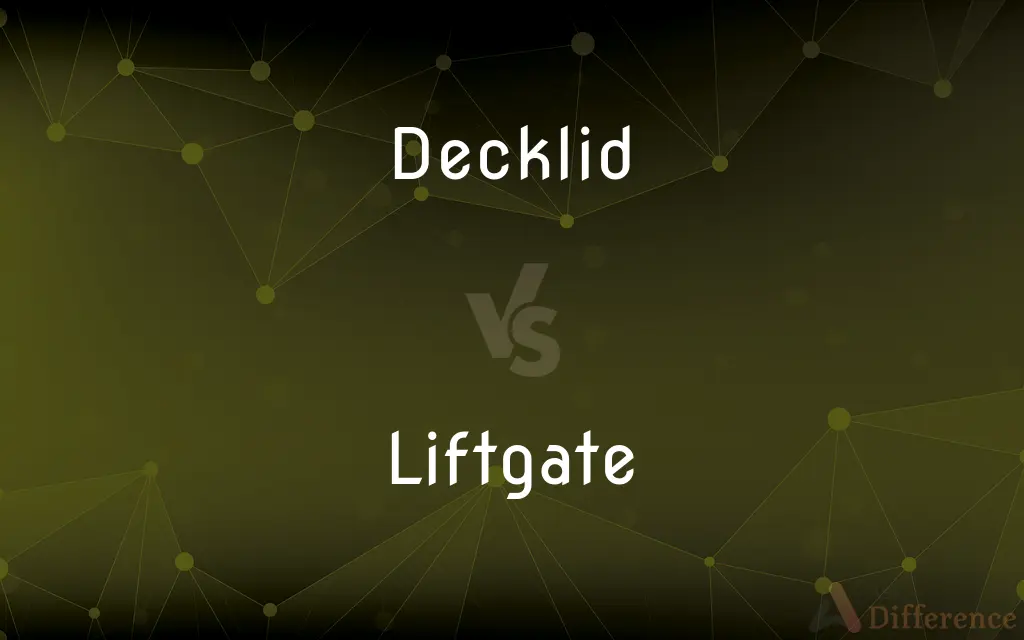Decklid vs. Liftgate — What's the Difference?
By Tayyaba Rehman & Urooj Arif — Updated on May 9, 2024
A decklid refers to the hinged cover that closes off the trunk area of a sedan or coupe, opening horizontally, while a liftgate is a rear door that swings upward on an SUV or hatchback, incorporating the rear window and providing access to cargo area.

Difference Between Decklid and Liftgate
Table of Contents
ADVERTISEMENT
Key Differences
Decklids are common in vehicles with a separate trunk compartment, such as sedans and coupes, where the rear window is fixed and not part of the opening. Liftgates, on the other hand, are integrated with the rear window and open vertically, primarily seen in SUVs, hatchbacks, and vans, offering a wider access point.
The functionality of a decklid is generally limited to providing access to the trunk space; it is a simple and traditional design used in many cars. Whereas, a liftgate is part of a more versatile vehicle design, facilitating easier loading and unloading of larger items due to its wider opening.
Aesthetically, decklids maintain the classic car profile with distinct trunk lines and are often designed to blend seamlessly with the car's rear contours. Liftgates, however, might alter a vehicle's profile to accommodate greater cargo space and practicality, contributing to the bulkier rear design typical of SUVs and hatchbacks.
In terms of convenience, decklids may require more space behind the vehicle to open fully, which can be a limitation in tight parking spaces. Liftgates provide vertical access, making them more convenient in limited spaces and often come with power-operated options for easier operation.
Security and sealing against the elements are critical for both, but the design of liftgates generally includes more complex sealing mechanisms due to the integration of the rear window, which can be a challenge for waterproofing and insulation compared to the simpler decklid design.
ADVERTISEMENT
Comparison Chart
Vehicle Type
Sedans, coupes
SUVs, hatchbacks, vans
Opening Mechanism
Horizontal swing
Vertical swing upward
Integration
Not integrated with the window
Includes the rear window
Primary Function
Access to trunk space
Access to cargo area, facilitates loading/unloading
Space Requirement
Requires horizontal space to open
Opens vertically, suitable for tight spaces
Compare with Definitions
Decklid
Separate from the vehicle’s rear window and typically less complex.
The classic coupe featured a manually operated, lockable decklid.
Liftgate
Found primarily on vehicles designed for utility and cargo space.
The family van featured a power-operated liftgate for added convenience.
Decklid
A rear car cover that opens horizontally to access the trunk.
The sedan’s decklid was smoothly contoured to match its sleek design.
Liftgate
A rear door that swings upward, including the rear window, for vehicle access.
The SUV’s liftgate made it easy to load large groceries.
Decklid
Often seen in traditional car designs with distinct trunk compartments.
Her vintage car had a chrome-trimmed decklid that added to its elegance.
Liftgate
Often equipped with advanced sealing and locking mechanisms.
The liftgate’s dual sealing system ensured that the cargo area was well insulated.
Decklid
Requires more clearance behind the vehicle to open fully.
He had to ensure enough room behind the car to open the decklid fully.
Liftgate
Compatible with power automation for ease of use.
With a press of a button, the liftgate automatically opened, simplifying access.
Decklid
Provides a secure and weather-resistant trunk closure.
The decklid’s rubber seals were replaced to prevent water from leaking into the trunk.
Liftgate
Facilitates better utilization of cargo space with less space restriction.
They chose a hatchback with a liftgate for easier gear loading on camping trips.
Decklid
An auto body panel that is the cover over the trunk (boot) of a motor vehicle.
Liftgate
A closure at the rear of a vehicle that can be raised during loading and unloading.
Liftgate
(truck equipment) A hydraulic or electric platform that installs onto the rear of a vehicle and which may be raised or lowered in the loading/unloading of heavy cargo
Liftgate
(automotive) A closure at the rear of a vehicle, or rear door, that can be raised to access the back of a vehicle
Common Curiosities
How do decklids and liftgates differ in function?
Decklids provide access to a separate trunk space, while liftgates offer access to the vehicle’s cargo area, often facilitating easier loading.
Which is better for tight parking spaces, a decklid or a liftgate?
A liftgate is more suitable for tight parking spaces since it opens vertically and does not require additional space behind the vehicle.
What is a decklid?
A decklid is the cover of a car's trunk, usually found on sedans and coupes, that opens horizontally.
Can you convert a decklid to a liftgate?
Converting a decklid to a liftgate is not typically feasible due to structural and design differences between vehicle types.
Do all SUVs have liftgates?
Most SUVs feature liftgates because of their practicality in loading and unloading cargo, but some models may have different designs.
What are the security features of decklids and liftgates?
Both decklids and liftgates are designed with locking mechanisms, though liftgates might also include additional features like remote opening and alarm systems.
What is a liftgate?
A liftgate is a type of rear door that includes the rear window and opens upward, typically used on SUVs, hatchbacks, and vans.
Which vehicles typically feature a decklid?
Decklids are typically featured on sedans and coupes, where a separate trunk compartment is standard.
Are liftgates more expensive to maintain than decklids?
Liftgates can be more expensive to maintain due to their complex mechanisms and integration with the rear window.
How do the sealing mechanisms differ between decklids and liftgates?
Liftgates often have more complex sealing mechanisms to incorporate the rear window and ensure the entire cargo area is protected from the elements.
Share Your Discovery

Previous Comparison
Impartiality vs. Objectivity
Next Comparison
Chitin vs. KeratinAuthor Spotlight
Written by
Tayyaba RehmanTayyaba Rehman is a distinguished writer, currently serving as a primary contributor to askdifference.com. As a researcher in semantics and etymology, Tayyaba's passion for the complexity of languages and their distinctions has found a perfect home on the platform. Tayyaba delves into the intricacies of language, distinguishing between commonly confused words and phrases, thereby providing clarity for readers worldwide.
Co-written by
Urooj ArifUrooj is a skilled content writer at Ask Difference, known for her exceptional ability to simplify complex topics into engaging and informative content. With a passion for research and a flair for clear, concise writing, she consistently delivers articles that resonate with our diverse audience.
















































